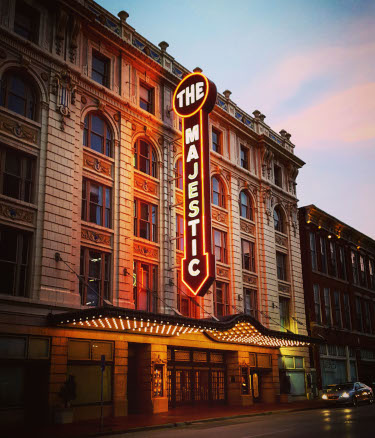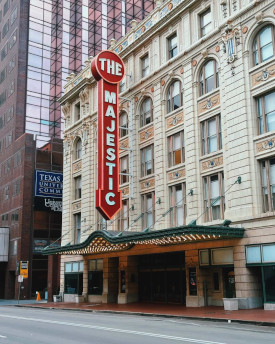Nestled in the heart of downtown Dallas, the Majestic Theatre is a testament to the city’s rich cultural heritage and its enduring love affair with the performing arts. This historic venue has played a pivotal role in shaping the cultural landscape of Dallas, hosting a myriad of performances that range from Broadway productions to musical concerts. As we delve into the history of the Majestic Theatre, we uncover a treasure trove of stories that showcase the venue’s evolution and its significance in the entertainment world.
Inception and Architectural Grandeur
The Majestic Theatre opened its doors on April 11, 1921, when vaudeville and silent films were at the zenith of popularity. John Eberson, a renowned architect, designed the architectural marvel celebrated for his atmospheric theaters. The Majestic, with its intricate terra cotta façade and opulent interior, was a shining example of the Beaux-Arts style, exuding elegance and grandeur.
The theater’s design was a departure from the conventional venues of the time. Eberson’s vision sought to transport audiences to a magical realm, and the Majestic did just that with its celestial-themed ceiling, reminiscent of an open-air Mediterranean courtyard under a starlit sky. The attention to detail, from the ornate plasterwork to the hand-painted murals, created an immersive experience that captivated patrons from the moment they stepped through the majestic doors.
The Golden Era of Vaudeville in Dallas Texas
In its early years, the Majestic Theatre became synonymous with vaudeville, a theatrical variety show that showcased a medley of acts, including comedians, musicians, dancers, and magicians. The venue’s stage hosted some of the most iconic performers of the time, turning the Majestic into a magnet for entertainment enthusiasts.
Legendary acts such as Harry Houdini, Mae West, and the Marx Brothers graced the Majestic stage, leaving an indelible mark on the theater’s legacy. The bustling atmosphere of vaudeville brought people from all walks of life together, creating a communal experience that resonated with the spirit of the Roaring Twenties.
The Majestic Theatre Transition to Cinema
As the entertainment landscape evolved, so did the Majestic Theatre. In the late 1920s, the advent of sound in cinema brought about a seismic shift in the industry. The Majestic adapted to this change, transforming into a movie palace equipped with state-of-the-art technology. The transition to cinema marked a new era for the theater, as it continued to enchant audiences with the magic of the silver screen.
The Majestic Theatre became a cultural hub, attracting moviegoers who sought a luxurious and enchanting cinematic experience. The ornate décor and plush seating added an extra layer of glamour to the movie-watching escapades of Dallas residents. The theater showcased a mix of Hollywood blockbusters and niche films, further solidifying its status as a premier entertainment venue.
Broadway's Texas Southern Gem
 In the mid-1970s, the Majestic Theatre underwent a restoration, recapturing its former glory and reestablishing itself as a live-form venue. Broadway productions soon found a home in Dallas, and the Majestic became a beacon for theater enthusiasts in the South. The theater’s stage witnessed the spectacle of iconic Broadway shows, bringing the magic of New York’s theater district to the heart of Texas.
In the mid-1970s, the Majestic Theatre underwent a restoration, recapturing its former glory and reestablishing itself as a live-form venue. Broadway productions soon found a home in Dallas, and the Majestic became a beacon for theater enthusiasts in the South. The theater’s stage witnessed the spectacle of iconic Broadway shows, bringing the magic of New York’s theater district to the heart of Texas.
One of the most memorable productions to grace the Majestic stage was the acclaimed musical “The Phantom of the Opera.” Andrew Lloyd Webber’s masterpiece enraptured audiences with its mesmerizing set design and unforgettable musical numbers, making the Majestic a pivotal stop for touring Broadway productions.
A Symphony of Sounds at The Majestic
Beyond Broadway, the Majestic Theatre has also hosted many musical performances, spanning genres from classical to contemporary. The acoustically rich environment of the venue has made it a favorite among musicians and orchestras. Renowned artists, including the Dallas Symphony Orchestra and luminaries like Ella Fitzgerald and Duke Ellington, have left an indelible mark on the Majestic’s musical legacy.
The theater’s versatility has allowed it to accommodate a wide range of musical acts, from rock and pop concerts to jazz ensembles and symphonic performances. Each note resonates within the hallowed halls, creating an immersive auditory experience that elevates the appreciation of live music.
Preservation Efforts and Historic Recognition in the DFW area
Recognizing the historical and cultural significance of the Majestic Theatre, preservation efforts have been undertaken to ensure its longevity. In 1977, the Majestic was listed on the National Register of Historic Places, cementing its status as a cultural landmark. Subsequent renovations in the 2000s enhanced the theater’s infrastructure while preserving its original charm.
The Majestic Theatre is today a living testament to the city’s commitment to preserving its cultural heritage. Its significance extends beyond entertainment, symbolizing Dallas’s resilience and dedication to fostering a vibrant arts scene.
If you get a chance, attend a performance at the Majestic Theatre
 The Majestic Theatre in Dallas is not merely a venue; it is a living chronicle of the city’s cultural evolution. From its inception as a vaudeville house to its golden era as a movie palace and its resurgence as a Broadway and music venue, the Majestic has weathered the sands of time with grace and elegance.
The Majestic Theatre in Dallas is not merely a venue; it is a living chronicle of the city’s cultural evolution. From its inception as a vaudeville house to its golden era as a movie palace and its resurgence as a Broadway and music venue, the Majestic has weathered the sands of time with grace and elegance.
As patrons step into the Majestic Theatre, they are transported to a bygone era, where the magic of live performances and the allure of the silver screen converge. The theater’s rich history, marked by iconic performances and cultural milestones, serves as a testament to the enduring power of the performing arts to captivate and inspire. In the heart of Dallas, the Majestic Theatre stands as a majestic reminder of the city’s commitment to preserving its cultural legacy for generations to come.
